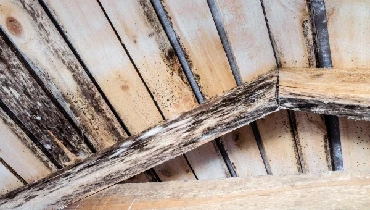
Aire Serv experts explain effective steps to remove attic mold and prevent its return.
- Identify and fix moisture sources, such as roof leaks or poor ventilation.
- Remove contaminated insulation and materials.
- Clean affected areas with mold-specific cleaners.
- Improve attic ventilation to reduce humidity.
- Monitor regularly to prevent future mold growth.
Although common, attic mold often grows undetected for months or even years. Mold in an attic can’t be overlooked as it may be harmful to your home and health if left untreated.
And just like the mold itself, the cause of growth is often undiscovered until the problem has grown. Usually, mold growth may be traced back to a leak or a problem with a home’s ventilation or insulation.
We can’t understate the danger mold poses in a home. Learn what to do should you discover mold in your attic and how to prevent future problems.
Why Is There Mold in My Attic?
Mold thrives in moisture. In winter, your home’s HVAC system is designed to produce warm, moist air to keep your home at a comfortable temperature and to make the air moist enough to breathe comfortably. But, when warm, moist air rises, it meets the cold air in your attic, creating condensation against your attic sheathing and floor. This dampness makes your attic a prime location for mold growth.
Aside from condensation, other scenarios may lead to mold growth. These include:
- Roof leaks. As your roof starts to age, natural wear and tear can cause water to seep through where it normally wouldn’t. Part of this is due to shingles lifting, weather damage, debris buildup, and more. Your attic will suffer the most from direct roof leakage.
- Siding/window leaks. Having improper seals or damaged windows and siding can allow any external or internal moisture to collect and sit.
- Air leaks. Because air contains water vapor, this moisture can get trapped in improperly sealed areas.
- Plumbing leaks. Pipe leaks can be tricky to spot but can cause problems and trapped moisture. If you see a wet spot on your wall or notice any water flow issues, you may need a proper inspection. A sewage leak, on the other hand, is an emergency concern and should be managed by professionals.
- Vents. If vents are blocked up or allowing improper airflow, hot air can collect and create condensation.
- Insufficient insulation. The hot air that rises from insufficient insulation can get trapped in your attic and mix with cold air to create condensation.
- Excessive moisture. Whether it’s a combination of these other factors or an overly warm home due to improper heating, ventilation, or humidifying, excessive moisture can become trapped in unwanted areas.
Mold remediation should always be completed by a skilled professional. Our Neighborly partners at Rainbow International can assist with any mold removal and remediation needs.
Related Topic: Catch the Culprits: Mold
Can You Clean Mold Yourself?
Removing mold in your attic can be a dangerous job, not just because of the mold itself but also because of the difficult working area. By attempting to address the issue yourself you put your health and safety at risk. Improper remediation may lead to the spread of mold spores and further damage to your home. Mold damage should always be remediated by a professional.
How to Remove Mold from Attic
We recommend that the moment you discover mold in your attic you contact a local remediation specialist. A qualified vendor will:
- Inspect for visible mold.
- Seal the area to keep your household safe from airborne mold spores.
- Identify the cause of the mold.
- Remove the mold and remediate damage to your attic
- Plan for prevention.
After the mold has been remediated, your Aire Serv technician will work with you to better regulate the moisture in your home and manage ventilation, to minimize the risk of mold growth in the future.
Related Topic: How to Clean Mold Out of Duct Work
How To Prevent Mold in Your Attic
Preventing mold growth in your home is two-fold. We recommend homeowners:
- Monitor for signs of leaks and mold growth regularly.
- Take steps to regulate the moisture in the air.
Homeowners who are concerned about the possibility of mold growth in their home should:
- Regularly inspect for roof leaks
- Have air ducts inspected and cleaned every 3-5 years
- Install an attic exhaust fan
- Ensure the home is adequately insulated
- Seal known air leaks
- Change HVAC air filters regularly
- Install a dehumidifier to control humidity
Need Help Preventing Mold in Your Attic?
Mold in your attic is most often an indication that you need to reconsider your home’s heating and cooling needs. Whether it’s because your HVAC system needs servicing or upgrading, your ducts need cleaning, your home needs better ventilation or humidification control, we can help. Call or request an appointment online to get started.

